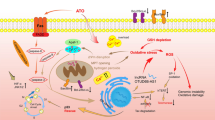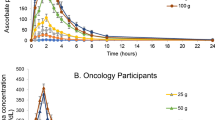Abstract
Aims. Arsenic trioxide (As2O3) is increasingly used to treat hematological malignancies. This involves daily intravenous (i.v.) administration for 4–8 weeks, with its attendant drawbacks: inconvenience, risks and expense of maintaining suitable vascular access and hospitalization. We therefore developed an oral formulation, administered it to patients and set out to assess the resulting systemic bioavailability of arsenic.
Methods. With ethics committee approval, nine patients with refractory/relapsed acute myeloid leukemia were recruited after giving informed consent. On day 1, each received 10 mg As2O3 by i.v. infusion over 1 h. Each patient swallowed 10 mg As2O3 in 10 ml oral solution 24 h later (day 2) and on subsequent days thereafter. Prior to and until 48 h post-i.v. dosing, timed venous blood samples were drawn and corresponding plasma and whole blood arsenic concentrations were determined by atomic absorption spectroscopy. Systemic bioavailability was inferred from the area under the arsenic level versus time curve (AUC) using the trapezoidal rule. Day-1 AUC after i.v. dosing was taken to be 100% and that attributed to oral dosing (day 2) was then calculated. The 48-h arsenic levels in blood cells were calculated using hematocrit values and corresponding plasma and whole blood arsenic concentrations.
Results. Respective day-2 mean plasma and blood AUCs attributed to oral dosing were 99% and 87% of corresponding day-1 values. On average, 48-h blood cell arsenic levels were 270% greater than in plasma (P=0.013). No patient suffered unexpected complications, and five went into remission.
Conclusions. Compared with i.v. dosing, our oral As2O3 formulation was more convenient and cost effective, and the ensuing systemic bioavailability of arsenic appeared similar. Arsenic seemed to be concentrated in the cellular fraction of blood 48 h after starting As2O3 treatment.
Similar content being viewed by others
Author information
Authors and Affiliations
Additional information
Electronic Publication
Rights and permissions
About this article
Cite this article
Kumana, .C., Au, .W., Lee, .N. et al. Systemic availability of arsenic from oral arsenic-trioxide used to treat patients with hematological malignancies. Eur J Clin Pharmacol 58, 521–526 (2002). https://doi.org/10.1007/s00228-002-0514-x
Received:
Accepted:
Issue Date:
DOI: https://doi.org/10.1007/s00228-002-0514-x




